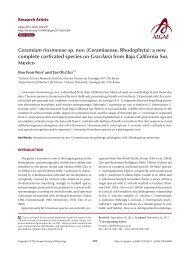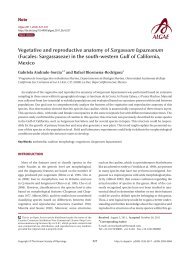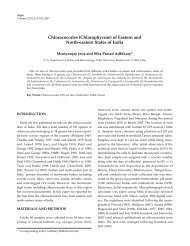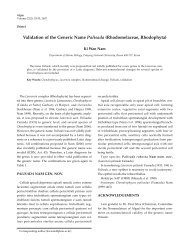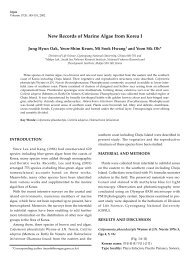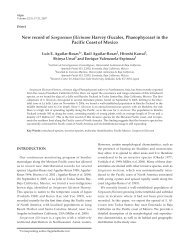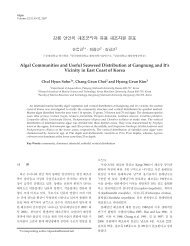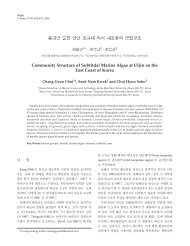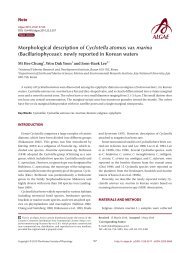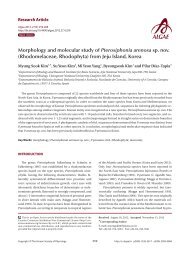First Description of Petalonia zosterifolia and Scytosiphon ... - Algae
First Description of Petalonia zosterifolia and Scytosiphon ... - Algae
First Description of Petalonia zosterifolia and Scytosiphon ... - Algae
You also want an ePaper? Increase the reach of your titles
YUMPU automatically turns print PDFs into web optimized ePapers that Google loves.
138 <strong>Algae</strong> Vol. 17(3), 2002Figs 1-5. <strong>Petalonia</strong> <strong>zosterifolia</strong>.1. Thallus collected on 12 January 2002 from the upper intertidal zone <strong>of</strong> Onyangri, Jukbyun on the East coast. scale bar = 2 cm.2. Rhizoidal filaments at the basal part <strong>of</strong> thallus. scale bar = 100 µm. 3. Small cortical cells on the surface <strong>of</strong> thallus. 4. Cross section<strong>of</strong> the middle axis showing medulla <strong>and</strong> cortex. 5. Cross section <strong>of</strong> the middle axis showing plurilocular sporangia <strong>and</strong>medullary cells. scale bars 3- 5 = 50 µm.
Cho et al.: <strong>Petalonia</strong> <strong>zosterifolia</strong> <strong>and</strong> <strong>Scytosiphon</strong> gracilis 139characterized by broad thalli (up to 3.5 cm in width) <strong>and</strong>the presence <strong>of</strong> rhizoidal cells in medulla (Kogame 1997).P. binghamiae is circumscribed by a small holdfast <strong>of</strong> rhizoid<strong>and</strong> numerous rhizoidal cells in medulla (Rhew <strong>and</strong>Boo 1991).P. <strong>zosterifolia</strong> appears to occur in winter, as does inJapan (Kogame <strong>and</strong> Kawai 1993). From our survey,Guryongpo appears the southern distribution <strong>of</strong> thatspecies in Korea. This is the first report on the occurrence<strong>of</strong> P. <strong>zosterifolia</strong> in Korea, recognized by both morphology<strong>and</strong> ITS region sequence data as discussed below.<strong>Scytosiphon</strong> gracilis Kogame (1998): 39Figs 6-10Type: SAP 059720 (collected in 1 February 1990).Type locality: Ohma, Aomori, JapanDistribution: Japan <strong>and</strong> KoreaKorean name: GaneunmiyeoksilRepresentative specimens examined: Hado, Jeju (Boo,CNUK 007399 - 007405, 4.ii.2000; CNUK 007406 - 007498,10.ii.2002).Morphology: Thalli were erect, flattened, unbranched,hollow, twisted in the upper part, 14-(25) cm long <strong>and</strong>up to 0.4 cm in width (Fig. 5). Rhizoids were developedfrom the outer cortical cells near the base <strong>of</strong> the thalli<strong>and</strong> were multiseriate filaments (Fig. 6).The thalli were hollow in mature <strong>and</strong> 70-115 µm inthickness. The tissues were parenchymatous <strong>and</strong> consisted<strong>of</strong> an outer cortex <strong>and</strong> medulla. In the middle part,medulla was composed <strong>of</strong> 1-3 layers <strong>of</strong> cells withoutplastids. Medullary cells were round to oval <strong>and</strong> c. 46 x36 µm in transverse section. The cortex consisted <strong>of</strong> 1-3layers <strong>of</strong> small, angular to rectangular cells. Each corticalcell had a plastid with a prominent pyrenoid.Plurilocular sporangia were developed from the surface<strong>of</strong> the upper parts <strong>of</strong> thalli <strong>and</strong> matured basipetally.Plurilocular sporangia were closely packed.Phaeophycean hairs were solitary or grouped on the surface.Ascocysts between unilocular sporangia wereabsent.<strong>Scytosiphon</strong> gracilis was epilithic on concrete block <strong>and</strong>rock, growing in the middle to the lower intertidal zonein relatively sheltered areas. Erect thalli occurred inFebruary in Hado on the east side <strong>of</strong> Jeju. Prostratesporophytes <strong>of</strong> S. gracilis (Kogame 1998) were not found.Taxonomic remarks: Our collections <strong>of</strong> S. gracilis fromJeju correspond to the original descriptions <strong>of</strong> Kogame(1998) <strong>and</strong> specimens from Aomori <strong>and</strong> HyogoPrefecture in Japan collected by Kazuhiro Kogame, theauthor <strong>of</strong> the original paper, <strong>and</strong> deposited in CNUK.<strong>Scytosiphon</strong> lomentaria is similar to S. gracilis, but is distinguishedby constricted thalli <strong>and</strong> Microspongium-likesporophyte (Kogame 1998). S. tenellus Kogame, which isreported only in Hokkaido <strong>of</strong> Japan, differs from ourspecies in having ascocysts between plurilocular sporangia<strong>of</strong> erect thalli <strong>and</strong> Stragularia-like, crust sporophyte(Kogame 1998). The last species <strong>of</strong> <strong>Scytosiphon</strong> in Japan isS. canaliculatus (Setchell <strong>and</strong> Gardner) Kogame, which ischaracterized by Hapterophycus-like sporophyte (Kogame1998).Although S. gracilis was included in our RuBisCospacer region phylogeny (Cho et al. 2001), this is the firstmorphological description <strong>of</strong> the species in Korea. S. gracilismay be a winter species in Korea, as in Japan(Kogame 1998). Considering its occurrence from thenorthern Hokkaido to the southern Fukuoka in Japan(Kogame 1998), detailed collections in the field mayprobably extend the distributional areas in Korea.Analysis <strong>of</strong> ITS region sequencesThe entire ITS region (ITS 1, 5.8S, <strong>and</strong> ITS 2) in 22 samples<strong>of</strong> five species ranged from 1069 bp in <strong>Scytosiphon</strong>gracilis to 823 bp in <strong>Petalonia</strong> binghamiae. The ITS 1 regionranged from 638 bp in S. gracilis to 385 bp in P. binghamiae.The ITS 2 region was much shorter than the ITS 1region <strong>and</strong> ranged from 276 bp in P. binghamiae to 251 bpin P. <strong>zosterifolia</strong>. The 5.8S subunit sequence was almostconserved <strong>and</strong> was 162 bp long in all species determinedhere. A comparison <strong>of</strong> the ITS region in the Ectocarpalesis shown in Table 2.The pairwise divergences <strong>of</strong> the ITS region sequencesaveraged 0.12% among seven samples <strong>of</strong> P. <strong>zosterifolia</strong>, inKorea, <strong>and</strong> zero in between two samples <strong>of</strong> S. gracilisfrom different years. The pairwise divergence averaged0.33% among five samples <strong>of</strong> P. binghamiae from thenorth Pacific, <strong>and</strong> 2.35% among seven samples <strong>of</strong> P. fasciafrom the north Pacific <strong>and</strong> the north Atlantic. Thepairwise divergence (22.83-22.43%) between P. <strong>zosterifolia</strong><strong>and</strong> other <strong>Petalonia</strong> species was much higher than that(13.62%) between P. <strong>zosterifolia</strong> <strong>and</strong> S. gracilis. In addition,S. gracilis differed from S. lomentaria by 31.78% inpairwise divergence.The NJ tree (Fig. 11) showed that seven samples <strong>of</strong><strong>Petalonia</strong> <strong>zosterifolia</strong> from different locations <strong>and</strong> twosamples <strong>of</strong> <strong>Scytosiphon</strong> gracilis from different years produceda single clade, respectively. These two specieswere again grouped into a monophyletic clade with amaximum support (Bootstrap value = 100%), which
140 <strong>Algae</strong> Vol. 17(3), 2002Figs 6-10. <strong>Scytosiphon</strong> gracilis.6. Thallus collected on 4 February 2000 from the intertidal zone <strong>of</strong> Hado, Jeju. scale bar = 1 cm. 7. Rhizoidal filaments at the basalpart <strong>of</strong> thallus. scale bar = 100 µm. 8. Rectangular cortical cells on the surface <strong>of</strong> thallus. 9. Cross section <strong>of</strong> the middle axis showingphaeophycean hairs, cortical cells, <strong>and</strong> medullary cells. 10. Cross section <strong>of</strong> the middle axis showing a large cavity in medulla.scale bars 8-10 = 50 µm.
Cho et al.: <strong>Petalonia</strong> <strong>zosterifolia</strong> <strong>and</strong> <strong>Scytosiphon</strong> gracilis 141Fig. 11. Neighbor-joining tree for <strong>Petalonia</strong> <strong>zosterifolia</strong> <strong>and</strong><strong>Scytosiphon</strong> gracilis rooted with S. lomentaria. Bootstrap values(> 50%) are given above branches.showed sister relationships to the clade <strong>of</strong> <strong>Petalonia</strong> binghamiae<strong>and</strong> P. fascia. The tree topology <strong>of</strong> the MP analysisshowed a similar pattern to that <strong>of</strong> the NJ tree. The strictconsensus <strong>of</strong> four most parsimonious trees when gapswere treated as missing data is shown in Figure 12.Despite the big difference in the length (Table 2), the ITS1 tree was similar to that <strong>of</strong> the ITS 2 tree in topology<strong>and</strong> bootstrap support (trees not shown). When gapswere treated as a fifth base, the MP analyses producedfour equally parsimonious trees (Fig. 12), having a minimallength <strong>of</strong> 1054 steps, a CI <strong>of</strong> 0.891, <strong>and</strong> a RI <strong>of</strong> 0.968(Table 3).DISCUSSION<strong>Petalonia</strong> <strong>zosterifolia</strong> is very similar to S. gracilis in habit<strong>and</strong> anatomy <strong>of</strong> the erect gametophytic thallus, <strong>and</strong>prostrate sporophytic crust (Kogame <strong>and</strong> Kawai 1993;Kogame 1998). The differences are structure <strong>of</strong> thallusFig. 12. Strict consensus <strong>of</strong> four maximum parsimonious treesfor <strong>Petalonia</strong> <strong>zosterifolia</strong> <strong>and</strong> <strong>Scytosiphon</strong> gracilis rooted withS. lomentaria, with gaps treated as missing data. The treelength was 648 steps, the consistency index was 0.9, <strong>and</strong>the retention index was 0.966. Bootstrap values (> 50%) aregiven above branches.<strong>and</strong> the presence/absence <strong>of</strong> paraphysis. The thallus <strong>of</strong>P. <strong>zosterifolia</strong> is solid but, when mature, sometimes hassmall cavities in medulla. In contrast, the thallus <strong>of</strong> S.gracilis is hollow. However, Kogame et al. (1999) reportedthat whether erect thalli are hollow or solid does notappear to be useful for distinguishing <strong>Petalonia</strong> <strong>and</strong><strong>Scytosiphon</strong>. Paraphyses are absent in P. <strong>zosterifolia</strong>(Rosenvinge <strong>and</strong> Lund 1947; Kogame <strong>and</strong> Kawai 1993),while unicellular paraphyses are present betweenunilocular sporangia in S. gracilis (Kogame 1998). Sinceparaphyses are consistently present in S. gracilis, theparaphysis may be an important criterion to recognize S.gracilis from P. <strong>zosterifolia</strong> (Kogame 1998). In this study,distribution ranges <strong>of</strong> P. <strong>zosterifolia</strong>, previously known inChina (Tseng 1983), Japan (Kogame <strong>and</strong> Kawai 1993),USA (Setchell <strong>and</strong> Gardner 1925), <strong>and</strong> the Atlantic(Fletcher 1987), <strong>and</strong> S. gracilis, previously reported only
Cho et al.: <strong>Petalonia</strong> <strong>zosterifolia</strong> <strong>and</strong> <strong>Scytosiphon</strong> gracilis 143between the species <strong>of</strong> <strong>Petalonia</strong>. The interspecific divergencesin the <strong>Scytosiphon</strong>aceae appear to be lower thanthose (18-34%) in the genus Elachista Duby <strong>of</strong> theChordariaceae (Uwai et al. 2001).Phylogenetic trees from all our data sets, e.g. ITS 1, ITS2, ITS region with gaps as missing data, <strong>and</strong> ITS regionwith gaps as a fifth character, consistently indicate theclose relationship (BP = 100) between P. <strong>zosterifolia</strong> <strong>and</strong> S.gracilis, that is congruent with results <strong>of</strong> analyses <strong>of</strong> rbcL,partial rbcS <strong>and</strong> partial 18S <strong>of</strong> nuclear ribosomal DNAsequences (Kogame et al. 1999), <strong>and</strong> the RuBisCo spacerregion sequences (unpublished data). The presence <strong>of</strong>prostrate Compsonema-like thallus in both P. <strong>zosterifolia</strong><strong>and</strong> S. gracilis is considered as a synapomorphic character(Kogame et al. 1999). Our molecular data togetherwith morphological evidence suggest that P. <strong>zosterifolia</strong><strong>and</strong> S. gracilis might have shared a common ancestor.Our ITS trees also show that <strong>Petalonia</strong> <strong>zosterifolia</strong> is clearlyseparated from other species <strong>of</strong> <strong>Petalonia</strong>. On the otherh<strong>and</strong>, P. binghamiae <strong>and</strong> P. fascia are closely related toeach other, sharing Strangularia-like sporophytic thalli(Kogame et al. 1999). In addition, S. gracilis is distantlyrelated to S. lomentaria, having a Microspongium-likesporophyte. Kogame et al. (1999) suggested that prostratesporophytes appear to be phylogenetically important.If this is true in the classification <strong>of</strong> the<strong>Scytosiphon</strong>aceae, the family needs a big change atgenus level (Kogame et al. 1999; Cho et al. 2001) <strong>and</strong> thetaxonomic revision <strong>of</strong> P. <strong>zosterifolia</strong> <strong>and</strong> S. gracilis shouldbe followed.The present study shows that two morphologicallysimilar species <strong>of</strong> brown algae can be easily classified bythe nrDNA ITS region sequences. The ITS region is verypowerful for recognizing hidden diversity <strong>of</strong> simplemorphologybrown algae e.g. the Ectocarpales <strong>and</strong> usefulfor studying biodiversity <strong>of</strong> other marine algae.ACKNOWLEDGEMENTSWe thank Dr. Kazuhiro Kogame <strong>of</strong> HokkaidoUniversity, Japan for help with identification <strong>and</strong>unpublished ITS data. This work is supported by a KRFgrant 2002-070-C00083 to SMB.REFERENCESCho G.Y., Yoon H.S., Choi H.G., Kogame K., <strong>and</strong> Boo S.M. 2001.Phylogeny <strong>of</strong> the family <strong>Scytosiphon</strong>aceae (Phaeophyta)from Korea based on sequences <strong>of</strong> plastid-encodedRuBisCo spacer region. <strong>Algae</strong> 16: 145-150.Dangeard P. 1962. Sur la reproduction et le développement de<strong>Petalonia</strong> <strong>zosterifolia</strong> (Reinke) Kuntze. C. r. hebd. Séanc. Acad.Sci. 254: 1895-1896.Draisma S.G., Prud’homme van Reine W.F., Stam W.T., <strong>and</strong>Olsen J.L. 2001. A reassessment <strong>of</strong> phylogenetic relationshipswithin the Phaeophyceae based on RUBISCO largesubunit <strong>and</strong> ribosomal DNA sequences. J. Phycol. 37: 586-603.Fletcher R.L. 1987. Seaweeds <strong>of</strong> the British Isles. Vo. 3.Fucophyceae (Phaeophyceae). Part I. British Museum(Natural History), London.Gilbert D.G. 1995. SeqPup, a biological sequence editor <strong>and</strong> analysisprogram for Macintosh computer. Biology Department,Indiana Univ., Bloomington.Kawai H., Muto H., Fuji T., <strong>and</strong> Kato A. 1995. A linked 5SrDNA gene in <strong>Scytosiphon</strong> lomentaria (<strong>Scytosiphon</strong>ales,Phaeophyceae). J. Phycol. 31: 306-311.Kogame K. 1997. Sexual reproduction <strong>and</strong> life history <strong>of</strong><strong>Petalonia</strong> fascia (<strong>Scytosiphon</strong>ales, Phaeophyceae). Phycologia36: 389-394.Kogame K. 1998. A taxonomic study <strong>of</strong> Japanese <strong>Scytosiphon</strong>(<strong>Scytosiphon</strong>ales, Phaeophyceae), including two newspecies. Phycol. Res. 46: 39-56.Kogame K. <strong>and</strong> Kawai H. 1993. Morphology <strong>and</strong> life history <strong>of</strong><strong>Petalonia</strong> <strong>zosterifolia</strong> (Reinke) Kuntze (<strong>Scytosiphon</strong>ales,Phaeophyceae) from Japan. Jpn J. Phycol. 41: 29-37.Kogame K., Horiguchi T., <strong>and</strong> Masuda M. 1999. Phylogeny <strong>of</strong>the order <strong>Scytosiphon</strong>ales (Phaeophyceae) based on DNAsequences <strong>of</strong> rbcL, partial rbcS, <strong>and</strong> partial LSU nrDNA.Phycologia 38: 496-502.Kuntze O. 1898. Revisio generum plantarum. Part III (1). I-IV+1-202+1-576.Muller D.G., Padori E.R. <strong>and</strong> Peters A.F. 1998. Asterocladon lobatumgen. et sp. nov., a new brown algal with stellatechloroplast arrangement, <strong>and</strong> its systematic positionjudged from nuclear rDNA sequences. Phycologia 37: 425-432.Peters A.F. <strong>and</strong> Burkhardt E. 1998. Systematic position <strong>of</strong> thekelp endophyte Laminarionema elsbetiae (Ectocarpales sensulato, Phaeophyceae) inferred from nuclear ribosomal DNAsequences. Phycologia 37: 114-120.Peters A.F. <strong>and</strong> Ramirez E. 2001. Molecular phylogeny <strong>of</strong> smallbrown algae, with special reference to the systematic position<strong>of</strong> Caepidium antarcticum (Adenocystaceae,Ectocarpales). Cryptogamie, Algol. 22: 187-200.Peters A.F., van Oppen M. J.H., Wiencke C., Stam W.T. <strong>and</strong>Olsen J.L. 1997. Phylogeny <strong>and</strong> historical ecology <strong>of</strong> theDesmarestiaceae (Phaeophyceae) support a southern hemisphereorigin. J. Phycol. 33: 294-309.Reinke J. 1889. Algenflora der westlichen Ostsee, DeutschenAntheils. Ber. comm. Wiss. Untersuch.dt. Meere 6: 1-101.Rhew K.S. <strong>and</strong> Boo S.M. 1991. Morphological variability inEndarachne binghamiae J. Agardh (Phaeophyta) from theEast coast <strong>of</strong> Korea. Korean J. Bot. 34: 45-51.Rosenvinge L.K. <strong>and</strong> Lund S. 1947. The marine algae <strong>of</strong>
144 <strong>Algae</strong> Vol. 17(3), 2002Denmark: Contributions to their natural history. Vol. II.Encoeliaceae, Mytriotrichiaceae, Giraudiaceae, Striariaceae,Dictyosiphonaceae, Chordaceae, <strong>and</strong> Laminariaceae. Kogel.Densk. Vidensk. Selsk., Biol. Skr. 4: 1-99.Rousseau F. <strong>and</strong> Reviers B. de. 1999. Circumscription <strong>of</strong> theorder Ectocarpales (Phaeophyceae): bibliographical synthesis<strong>and</strong> molecular evidence. Cryptogamie, Algol. 20: 5-18.Saunders G.W. <strong>and</strong> Druehl L.D. 1993. Nucleotide sequences <strong>of</strong>the internal transcribed spacers <strong>and</strong> 5.8S rRNA genes fromAlaria marginata <strong>and</strong> Postelsia palmaeformis (Phaeophyta:Laminariales). Mar. Biol. 115: 347-352.Serrao E.A., Alice L.A., <strong>and</strong> Brawley S.H. 1999. Evolution <strong>of</strong> theFucaceae (Phaeophyta) inferred from nrDNA-ITS. J. Phycol.35: 382-394.Setchell W.A. <strong>and</strong> Gardner N.L. 1925. The Marine algae <strong>of</strong> thePacific coast <strong>of</strong> North America: Part III. Melanophyceae.Univ. Calif. Publ. Bot. 8: 383-898.Stache-Crain B., Müller D.G., <strong>and</strong> G<strong>of</strong>f L.J. 1997. Molecular systematics<strong>of</strong> Ectocarpus <strong>and</strong> Kuckuckia (Ectocarpales,Phaeophyceae) inferred from phylogenetic analysis <strong>of</strong>nuclear- <strong>and</strong> plastid-encoded sequences. J. Phycol. 33: 152-168.Sw<strong>of</strong>ford D.L. 2001. PAUP*: Phylogenetic Analysis UsingParsimony (* <strong>and</strong> Other Methods). version 4.0b8. Sinauer,Sunderl<strong>and</strong>, MA.Tseng C.K. 1983. Common Seaweeds <strong>of</strong> China. Science Press,Beijing.Uwai S., Kogame K., <strong>and</strong> Masuda M. 2001. Reassessment <strong>of</strong> thetaxonomic status <strong>of</strong> Elachista tenuis <strong>and</strong> related species(Elachistaceae, Phaeophyceae), based on culture studies<strong>and</strong> molecular phylogenetic analyses. Eur. J. Phycol. 36:103-111.Wynne M.J. 1969. Life history <strong>and</strong> systematic studies <strong>of</strong> somePacific North American Phaeophyceae (brown algae).Univ. Calif. Publ. Bot. 50: 1-88.Yoon H.S., Lee J.Y., Boo S.M., <strong>and</strong> Bhattacharya D. 2001.Phylogeny <strong>of</strong> Alariaceae, Laminariaceae, <strong>and</strong> Lessoniaceae(Phaeophyceae) based on plastid-encoded RuBisCo spacer<strong>and</strong> nuclear-encoded ITS sequence comparisons. Mol.Phylog. Evol. 21: 231-243.Accepted 31 August 2002



